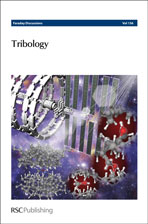Synovial fluid lubrication of artificial joints: protein film formation and composition
Abstract
Despite design improvements, wear of artificial implants remains a serious health issue particularly for Metal-on-Metal (MoM) hips where the formation of metallic wear debris has been linked to adverse tissue response. Clearly it is important to understand the fundamental lubrication mechanisms which control the wear process. It is usually assumed that MoM hips operate in the ElastoHydrodynamic Lubrication (EHL) regime where film formation is governed by the bulk fluid viscosity; however there is little experimental evidence of this. The current paper critically examines synovial fluid lubrication mechanisms and the effect of synovial fluid chemistry. Two composition parameters were chosen;
- This article is part of the themed collection: Tribology

 Please wait while we load your content...
Please wait while we load your content...